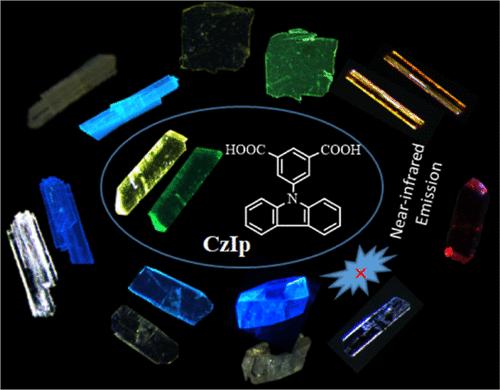当前位置:
X-MOL 学术
›
Cryst. Growth Des.
›
论文详情
Our official English website, www.x-mol.net, welcomes your feedback! (Note: you will need to create a separate account there.)
Solid-State Assembly and Photoluminescent Behavior of 5-(9H-Carbazol-9-yl)isophthalic Acid–Based Molecular Crystals Influenced by Solvents and Organic Counterparts
Crystal Growth & Design ( IF 3.2 ) Pub Date : 2024-06-03 , DOI: 10.1021/acs.cgd.4c00446 Hui-Min Tang 1 , Zheng-Yang Quan 1 , Bo Ding 1 , Xiu-Guang Wang 1 , Bo Tang 1 , Zheng-Guo Huang 1 , En-Cui Yang 1
Crystal Growth & Design ( IF 3.2 ) Pub Date : 2024-06-03 , DOI: 10.1021/acs.cgd.4c00446 Hui-Min Tang 1 , Zheng-Yang Quan 1 , Bo Ding 1 , Xiu-Guang Wang 1 , Bo Tang 1 , Zheng-Guo Huang 1 , En-Cui Yang 1
Affiliation

|
Molecular crystals with desirable structures and tunable photoluminescence are highly important for multiscenario field applications as lasers, sensors, and light-emitting devices. However, purposeful controls on the photoluminescence are still challenging because of the high sensitivity of molecular stackings to molecular structures and surroundings. Herein, solid-state assembly and photoluminescent behavior of nine 5-(9H-carbazol-9-yl) isophthalic acid (CzIp)-based molecular crystals have been crystallographically, spectroscopically, and theoretically investigated by incorporation with electron-deficient acceptors and polar solvent molecules. As compared to the self-aggregation of green-emissive CzIp, methanol-solvated CzIp-CH3OH and hydrated CzIp-H2O exhibit tailorable structural overlaps for the π-stacked CzIp–CzIp dimers, emitting high-energy cyan and blue fluorescence upon excitation by UV light. These blue-shifted emissions are from different local excited states of the π-stacked dimers. By contrast, six cocrystals with 1:1 and 2:1 stoichiometry and/or cocrystallized solvent are constructed, respectively, from the π–π stacked CzIp-acceptor or CzIp–CzIp pairs, which are assembled into one-dimensional ribbons (for CzIp-OFN, CzIp-TCNB, CzIp-DCTFB, and CzIp-TCNQ, OFN = octafluoronaphthalene, TCNB = 1,2,4,5-tetracyanobenzene, DCTFB = 2,3,5,6-tetrafluoro-1,4-dicyanobenzene, and TCNQ = 7,7,8,8-tetracyanoquinodimethane), two-dimensional sheet (for CzIp-DITFB, DITFB = 1,4-diiodotetrafluorobenzene), and discrete cyclic tetramer (for CzIp-TND, TND = 1,4,5,8-naphthalenetetracarboxdiimide) through intermolecular hydrogen- and halogen-bonding interactions. These cocrystals emit switchable emissions from quenched fluorescence to intense blue, green, orange, and near-infrared photoluminescence. Further structural comparisons and theoretical calculations demonstrate that the wide-range multicolor luminescence is either from the local excited state or from the charge transfer, in which the π-stacked donor–acceptor pair, suitable energy levels, and band gap, as well as rational hole–electron distributions, manipulate synergistically the charge transfer-induced photoluminescence. These findings offer in-depth insights into the relationships of molecular stackings and photoluminescence, advancing the development of organic luminescence crystals with desirable optoelectronic properties.
中文翻译:

溶剂和有机对应物影响下 5-(9H-咔唑-9-基)间苯二甲酸基分子晶体的固态组装和光致发光行为
具有所需结构和可调谐光致发光的分子晶体对于激光器、传感器和发光器件等多场景领域应用非常重要。然而,由于分子堆积对分子结构和周围环境的高度敏感性,对光致发光的有目的的控制仍然具有挑战性。在此,通过结合缺电子受体和极性溶剂,对九种 5-(9H-咔唑-9-基) 间苯二甲酸 (CzIp) 基分子晶体的固态组装和光致发光行为进行了晶体学、光谱和理论研究分子。与绿光发射 CzIp 的自聚集相比,甲醇溶剂化的 CzIp-CH 3 OH 和水合 CzIp-H 2 O 表现出可定制的 π 堆叠 CzIp 结构重叠–CzIp 二聚体,在紫外光激发下发射高能青色和蓝色荧光。这些蓝移发射来自 π 堆叠二聚体的不同局部激发态。相比之下,六个具有 1:1 和 2:1 化学计量和/或共结晶溶剂的共晶体分别由 π-π 堆叠的 CzIp 受体或 CzIp-CzIp 对构建而成,它们被组装成一维带状(对于 CzIp -OFN、CzIp-TCNB、CzIp-DCTFB 和 CzIp-TCNQ,OFN = 八氟萘,TCNB = 1,2,4,5-四氰基苯,DCTFB = 2,3,5,6-四氟-1,4-二氰基苯, TCNQ = 7,7,8,8-四氰基醌二甲烷)、二维片(对于 CzIp-DITFB,DITFB = 1,4-二碘四氟苯)和离散环状四聚体(对于 CzIp-TND,TND = 1,4,5 ,8-萘四甲二亚胺)通过分子间氢键和卤素键相互作用。 这些共晶体发出可切换的发射光,从淬灭荧光到强烈的蓝色、绿色、橙色和近红外光致发光。进一步的结构比较和理论计算表明,宽范围的多色发光要么来自局域激发态,要么来自电荷转移,其中π堆叠的供体-受体对、合适的能级和带隙以及有理数空穴电子分布,协同操纵电荷转移引起的光致发光。这些发现为分子堆叠和光致发光的关系提供了深入的见解,推动了具有理想光电特性的有机发光晶体的开发。
更新日期:2024-06-03
中文翻译:

溶剂和有机对应物影响下 5-(9H-咔唑-9-基)间苯二甲酸基分子晶体的固态组装和光致发光行为
具有所需结构和可调谐光致发光的分子晶体对于激光器、传感器和发光器件等多场景领域应用非常重要。然而,由于分子堆积对分子结构和周围环境的高度敏感性,对光致发光的有目的的控制仍然具有挑战性。在此,通过结合缺电子受体和极性溶剂,对九种 5-(9H-咔唑-9-基) 间苯二甲酸 (CzIp) 基分子晶体的固态组装和光致发光行为进行了晶体学、光谱和理论研究分子。与绿光发射 CzIp 的自聚集相比,甲醇溶剂化的 CzIp-CH 3 OH 和水合 CzIp-H 2 O 表现出可定制的 π 堆叠 CzIp 结构重叠–CzIp 二聚体,在紫外光激发下发射高能青色和蓝色荧光。这些蓝移发射来自 π 堆叠二聚体的不同局部激发态。相比之下,六个具有 1:1 和 2:1 化学计量和/或共结晶溶剂的共晶体分别由 π-π 堆叠的 CzIp 受体或 CzIp-CzIp 对构建而成,它们被组装成一维带状(对于 CzIp -OFN、CzIp-TCNB、CzIp-DCTFB 和 CzIp-TCNQ,OFN = 八氟萘,TCNB = 1,2,4,5-四氰基苯,DCTFB = 2,3,5,6-四氟-1,4-二氰基苯, TCNQ = 7,7,8,8-四氰基醌二甲烷)、二维片(对于 CzIp-DITFB,DITFB = 1,4-二碘四氟苯)和离散环状四聚体(对于 CzIp-TND,TND = 1,4,5 ,8-萘四甲二亚胺)通过分子间氢键和卤素键相互作用。 这些共晶体发出可切换的发射光,从淬灭荧光到强烈的蓝色、绿色、橙色和近红外光致发光。进一步的结构比较和理论计算表明,宽范围的多色发光要么来自局域激发态,要么来自电荷转移,其中π堆叠的供体-受体对、合适的能级和带隙以及有理数空穴电子分布,协同操纵电荷转移引起的光致发光。这些发现为分子堆叠和光致发光的关系提供了深入的见解,推动了具有理想光电特性的有机发光晶体的开发。







































 京公网安备 11010802027423号
京公网安备 11010802027423号